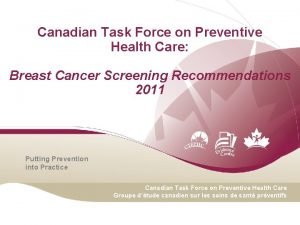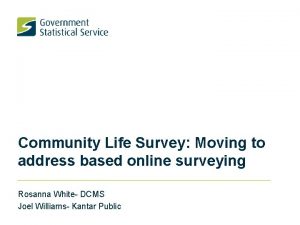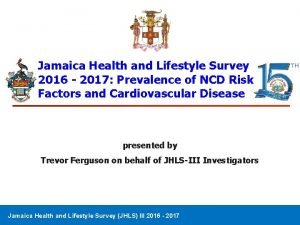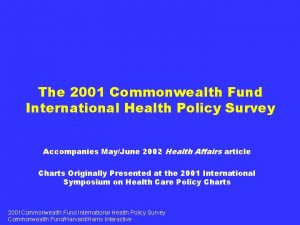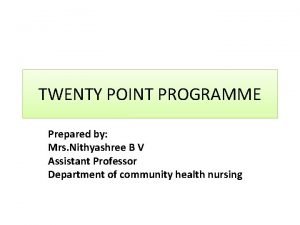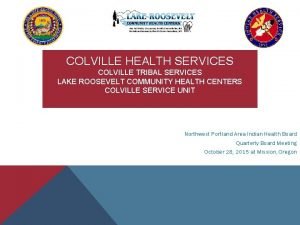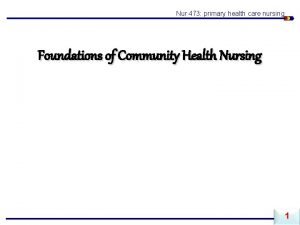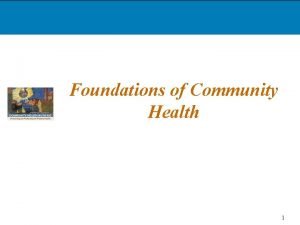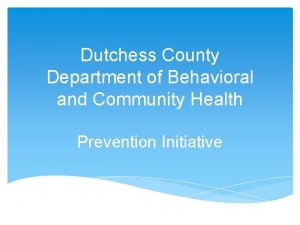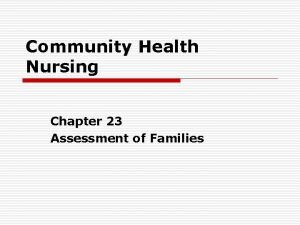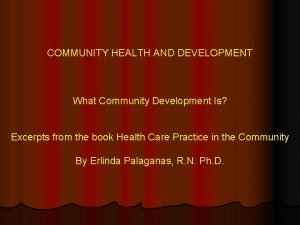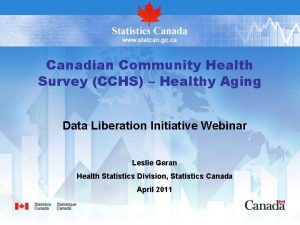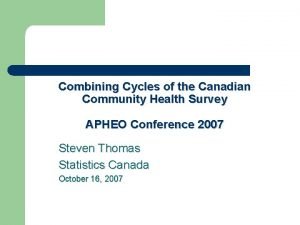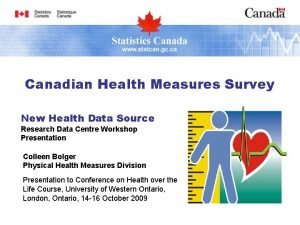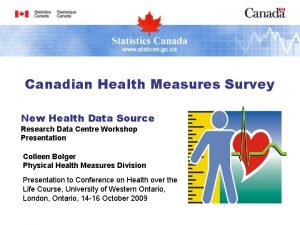Canadian Community Health Survey Cycle 2 2 2004













































- Slides: 45

Canadian Community Health Survey Cycle 2. 2 (2004) – Nutrition ONTARIO DLI TRAINING 2006 Guelph, April 10 – April 13, 2006 Ingrid Ledrou Health Statistics Division Statistics Canada

Presentation overview l CCHS design – “. 1’s” & “. 2’s” l CCHS 2. 2 (2004) - Nutrition ª general health component ª 24 -hour recall component l Data files – releases, Web, PUMF l … on a “heavier note”… 2

CCHS Design “. 1’s” vs “. 2’s”

CCHS - objectives Provide timely, consistent, cross-sectional estimates of health determinants, health status and health system utilization across Canada l Sub-provincial geography (“. 1’s”) l ª 100++ l health regions Flexible survey instrument ª meet specific health region data needs ª quick response to emerging issues ª provide focused survey content for key gaps (“. 2’s”) data 4

CCHS - 2 -year cycle design Year 1 – “General” Year 2 – “Focus” 130, 000 respondents l stratified by health region l Content ª common ª optional ª sub-sample l Estimates for health regions, provinces, territories, Canada l l 30, 000 respondents l stratified by province l Content ª focus ª correlates ª 60+ minutes l Estimates for provinces, Canada (excluding territories) 5

CCHS - status Cycle 1. 1 (2000 -2001) l l l General content 130 000+ sample health region estimates initial release: May, 2002 PUMF ☻ Cycle 2. 1 (2003) l l l General content 130 000+ sample health region estimates initial release: June, 2004 PUMF ☻ Cycle 1. 2 (2002) - focus l l l Mental health & well being ~30 000 sample provincial estimates initial release: Sept. , 2003 PUMF ☻ Cycle 2. 2 (2004) - focus Nutrition ~30 000 sample provincial estimates Two-stage release: July 2005 & May 2006 l PUMF x 2 ☺ l l 6

CCHS - status Cycle 3. 1 (2005) l l l General content 130 000+ sample health region estimates 6 -mth data release: Dec, 2005 full release: June, 2006 PUMF ☺ Cycle ? 4. 1 ? (2006+) l l l General content 130, 000+ sample continuous ? HR estimates w/more flexibility staggered releases PUMF (24 months) ☺ Canadian Health Measures Survey (2006) Cycle ? 4. 2 ? (2008) l l Focus content aging ? PUMF ☺ 7

CCHS 2. 2 (2004) - Nutrition

A brief history l Nutrition ª Nutrition Canada, 1972 • last national population based data on food consumption and related nutrition assessment with physical and biological measurements ª Health 1990’s l Canada’s provincial nutrition surveys, Physical measurements ª Canada Health Survey, 1978 -79, national ª Canadian Heart Health Surveys, 1986 to 1992, different provinces 9

A brief history l CCHS 2. 2 – Nutrition ª feasibility study for CCHS focus content on nutrition: initiated late 1999 ª development begins: Spring 2002 ª collection: Jan. – Dec. 2004 ª first results released: July, 2005 • PUMF: December 2005 ª complete release: • PUMF: ~ Fall 2006 Feb, 2006 10

CCHS 2. 2 - goals l Provide reliable, detailed, and timely information on dietary intake, nutritional well-being and their key determinants l To inform and guide programs, policies and activities of federal and provincial governments as well as local health agencies 11

CCHS 2. 2 - objectives l Estimate the distribution of usual dietary intake in terms of foods, food groups, dietary supplements, nutrients and eating patterns ª for a representative sample of Canadians at provincial and national levels ª Measure the prevalence of household food insecurity among various population groups in Canada l Gather anthropometric measurements l ª l body height and weight Collect correlate information physical activity ª selected health conditions ª socio-demographic characteristics ª 12

Sample design - domains l Distribution of usual dietary intake for a representative sample at provincial and national levels 15 key domains of interest = Dietary Reference Intakes (DRI), as specified by the American Institute of Medicine ª DRI age/sex groups: – <1 both sexes – 1 -3 both sexes – 4 -8 both sexes – 9 - 13 m - f separate – 14 - 18 m - f separate – 19 - 30 m - f separate – 31 - 50 m - f separate – 51 - 70 m - f separate – 71 + m - f separate ª 13

Sample design - coverage l Target population individuals, aged 0 +, living in private occupied dwellings in each of the ten provinces ª exclusions: ª • • • l Coverage ª l 3 territories individuals living on Aboriginal Reserves and Crown Lands residents of institutions full-time members of the Canadian Forces residents of some remote areas ~98% of the Canadian population living in the provinces Buy-ins ª target groups / geography 14

Sample design - allocation l l Initial target sample size: 30, 000 responding units Two-step approach ª step 1 • 1, 120 units to each province • 80 for each of 14 DRI groups (minimum of 80 units is not a requirement for the < 1 age grp) ª step 2 • remaining 18, 800 units allocated to the provinces using a power allocation scheme (q = 0. 70) l Two frames ª ª l l LFS area frame CCHS 2. 1 frame Buy-ins from ON, PEI, MAN and Health Canada Total sample size = 35, 100 units 15

CCHS 2. 2 content l Two components ª 24 -hour dietary recall component • collect information on all foods & beverages during 24 hour period of reference ª general health component • collect correlates & socio-demographics – – – selected health conditions physical / sedentary activity vitamins & minerals supplements height & weight (self-reported, measured) … 16

CCHS 2. 2 content 24 -hour dietary recall l All foods & beverages consumed during 24 hour period of reference ª midnight to midnight the day prior to the interview ª details - what ª amounts – how much l CAI application ª developed by the United States Department of Agriculture ª automated multiple pass methodology 17

CCHS 2. 2 content 24 -hour dietary recall l Modified to fit Canadian marketplace ª to account for differences in foods available • beaver tails, poutine… ª ª ª l in collaboration with Health Canada contains ~27, 000 foods within look-up lists translated into French Automated multiple pass methodology ª 5 steps designed to improve the respondent’s ability to remember what foods and beverages were consumed during the 24 -hour period of reference 1. 2. 3. 4. 5. Quick List – quick report Forgotten Foods – anything else with that? Time and Occasion – when / group items Detail Cycle – describe, prep, additions, amounts, where Final Probe – any other food / beverage 18

CCHS 2. 2 content 24 -hour dietary recall l Second recall ª calculate intra-individual variability ª subsample of 10, 000 units (CATI) ª 3 to 10 days after the first interview, preferably a different day of the week ª minimum of 125 individuals for each of the 15 DRI/sex groupings by region • Atlantic, Quebec, Ontario, Prairies, BC • 50 respondents ~ collapse by region not necessary l Intake distribution software 19

CCHS 2. 2 content general health l l l l General Health (12+) Physical Activity (12+) Children’s Physical Activity (6 to 11) Sedentary Activity (12 - 17) Measured Height and Weight (2+) Self Reported Height and Weight (10% sample, 18+) Vitamin and Mineral Supplements (all) Household Food Security (all) l l l Fruit and Vegetable Consumption (6 mo. +) Women’s Health (9+) Chronic Conditions (all) Smoking (12+) Alcohol Consumption (12+) Socio-Demographics (all) l Labour Force (15 - 75) l Income (all) l 20

Data collection - design l Four quarterly samples ª l 60 -minute CAPI interview ª ª l Respondents aged 12+: non proxy Aged 6 to 11: assisted proxy (respondent and parent) Aged 0 to 5: full proxy (parent only) Responses rates ª ª l including the 1 st 24 -hour recall and physical measures anticipated response rate: 80% • 85% for fresh sample • 75% for 2. 1 sample of households Proxy interview protocols ª ª ª l Jan. to Dec. 2004 1 st interview = 76. 5% 2 nd interview = 72. 8 % Item response rate for measured height and weight = 63% 21

Data collection – sample sizes 1 st interview 2 nd interview Canada 35, 107 10, 786 NL 1, 734 752 PE 1, 430 860 NS 1, 705 704 NB 1, 633 683 PQ 4, 780 1, 964 ON 10, 921 1, 647 MB 4, 194 921 SK 2, 041 894 AB 3, 021 767 BC 3, 648 1, 564 22

Data release(s) – 2 steps CCHS 2. 2 data are being released in two steps ª Step 1: general health component • except vitamin & mineral supplements ª Step 2: 24 -hour recall (nutrition) component • including vitamin & mineral supplements – pending validation – release postponed 23

Data release(s) – step 1 Step 1: General health component - July 6, 2005 l Single flat file l ª 2 sampling weights • general • measured body height & weight l l PUMF - Dec. 5, 2005 Internet Publication ª “Nutrition: Findings from the Canadian Community Health Survey” • 2 articles: adult and children obesity • CANSIM tables 24

Data release(s) – step 1 l I-Pub: “Nutrition: Findings from the Canadian Community Health Survey” ª 2 analytical articles • “Adult obesity in Canada: Measured height and weight”, Michael Tjepkema, STC • “Overweight Canadian children and adolescents”, Margot Shields, STC ª CANSIM tables • adult measured BMI, child measured BMI, food insecurity, children’s physical activity, teenager’s sedentary activity 25

26

27

28

29

30

31

32

33

34

Data release(s) – step 1 l PUMF - Dec. 5, 2005 ª Single flat file • 2 sampling weights – general – measured body height & weight ª Documentation • user guide • data dictionary • derived variables • syntax files / layouts (SAS & SPSS) ª B 20/20 utility x 2 • user-defined tabulations 35

Data release(s) – step 2 l l Step 2: Nutrition – May 18, 2006 Assigning food codes to ~ 750, 000 records ª with Health Canada coding to Canadian Nutrient File ª calculate nutritional profiles for each food using a processing system designed by Health Canada for provincial nutrition surveys l l l Re-issue Step 1 data Intake distribution software ? No PUMF (including Step 1 data) – Fall 2006 45

Data release(s) – step 2 l 4 flat files ª general health and nutritional summary • 1 record per respondent ª vitamin and mineral supplements file • 1 record per supplement reported • Pending validation • Release postponed ª food details file • 1 record per food reported ª day 1 and 2 intake summary file • 1 record per intake day data file – 1 record for 2/3 of respondents, 2 records for 1/3 of respondents 46

Roll Up 47

Data release(s) – step 2 nutrition variables l l l l l Protein Fat (total lipids) Carbohydrate, total Energy (kilocalories) Alcohol Mositure Caffeine Energy (kilojoules) Sugars (total) Fibre, total dietary Calcium Iron Magnesium Phosphorous Potassium Sodium Zinc Vitamin D (IU) Viitmin D (micrograms) l l l l l Vitamin C Thiamin Riboflavin Total Niacin Equivalent Vitamin B 6 Total Folacin Vitamin B 12 Folic Acid Cholesterol Fatty Acids, Saturated, Total Fatty Acids, Polyunsaturated, 18: 2, Linoleic Fatty Acids, Polyunsaturated, 18: 3, Linolenic Fatty Acids, Monounsaturated, Total Fatty Acids, Polyunsaturated, Total Naturally Occuring Folate Retinol, Activity Equivalents Dietary Folate Equivalent 48

Training & support l Proper use of data / files l Use of intake distribution software l Health Canada – interpretation guide l STC / CIHR RFA funding research ª RDCs 49

Data release(s) – obesity l Body Mass Index (BMI) ªa measure of person’s weight in relation to his/her height ª highly correlated with body fat and is widely used to indicate a person’s potential health risks l Measuring BMI ª metric: • BMI = weight (kg) / height (m)2 ª imperial: • BMI = weight (lb) / height (inches)2 x 703 50

Data Release(s) – Obesity l Body Mass Index (BMI) ª Canadian guidelines • in keeping with those of the WHO, classifies BMI into six categories, each representing a certain level of risk to one’s health Category BMI value Risk level underweight normal weight overweight obese class III BMI < 18. 5 < BMI < 24. 9 25. 0 < BMI < 29. 9 30. 0 < BMI < 34. 9 35. 0 < BMI < 39. 9 BMI ≥ 40. 0 increased least increased high very high extremely high 51

Measured Obesity Rates by Age Canada Health Survey (1978/79) and CCHS (2004) * * * F 52

Obesity Rate Over Time, Age 18+ 1978/79 – 2004 Measured Self-reported 53

Contact Info Mario Bédard (613) 951 -8933 mario. bedard@statcan. ca Ingrid Ledrou (613) 951 -6567 ingrid. ledrou@statcan. ca Data Access Unit Population Health Surveys (NPHS, CCHS) Health Statistics Division Statistics Canada cchs-escc@statcan. ca nphs-ensp@statcan. ca 54
 Evaluate together in community mobilization
Evaluate together in community mobilization Canadian community economic development network
Canadian community economic development network Canadian association for community living
Canadian association for community living Association of canadian community colleges
Association of canadian community colleges Role and responsibility of occupational health nurse
Role and responsibility of occupational health nurse Abcd survey
Abcd survey Canadian task force on preventive health care
Canadian task force on preventive health care Ccsmh
Ccsmh Community right to know survey nj
Community right to know survey nj Community life survey
Community life survey Jamaica health and lifestyle survey 2019
Jamaica health and lifestyle survey 2019 Ehis eurostat
Ehis eurostat California health information survey
California health information survey Commonwealth fund international health policy survey
Commonwealth fund international health policy survey Medicare health outcomes survey
Medicare health outcomes survey European health literacy survey
European health literacy survey Mipha full form in medical
Mipha full form in medical Lenawee community mental health authority
Lenawee community mental health authority Van buren community mental health
Van buren community mental health Twenty point programme slideshare
Twenty point programme slideshare Purpose of nursing process
Purpose of nursing process Nursing diagnosis as evidenced by
Nursing diagnosis as evidenced by Nurse collaborator role
Nurse collaborator role Community health nursing principles
Community health nursing principles The nursing process
The nursing process Nursing care plan hallucinations
Nursing care plan hallucinations Ccbhc nevada
Ccbhc nevada Objective of national mental health programme
Objective of national mental health programme Family and community health advisor
Family and community health advisor Nursing community diagnosis examples
Nursing community diagnosis examples Bag technique definition
Bag technique definition Colville indian health center
Colville indian health center Historical development of community health nursing
Historical development of community health nursing Evolution of community health
Evolution of community health Oakland county health network
Oakland county health network Principal of home visit
Principal of home visit Primary health care principles
Primary health care principles 3 phases of home visit
3 phases of home visit Che network
Che network Georgia department of community health
Georgia department of community health Eight characteristics of community health nursing
Eight characteristics of community health nursing Dutchess county mental hygiene
Dutchess county mental hygiene Downtown community health clinic
Downtown community health clinic Coquille indian tribe community health center
Coquille indian tribe community health center Family care plan in community health nursing
Family care plan in community health nursing Ce winslow goal of public health
Ce winslow goal of public health






